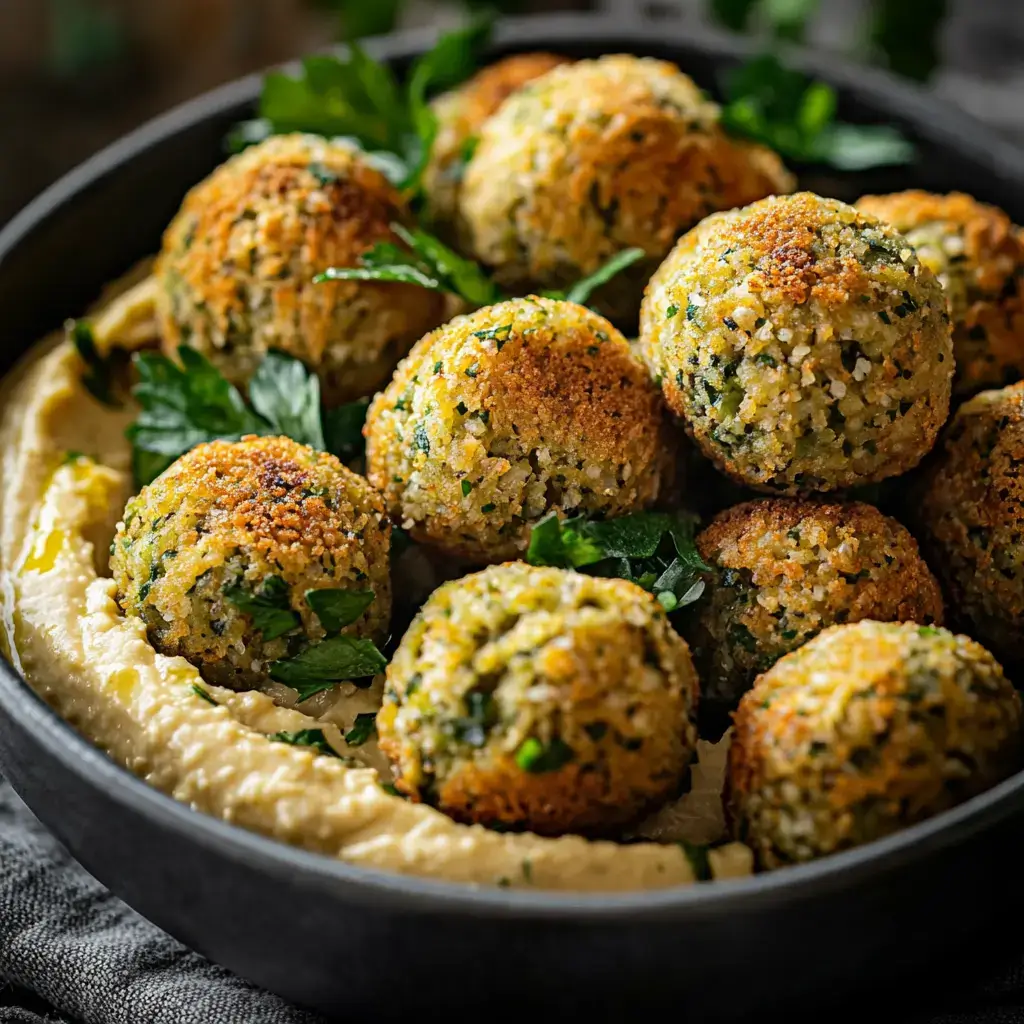Introduction
If you’re in search of a delectable and satisfying meal that’s both nutritious and rich in flavor, look no further than mini falafel balls with hummus. This Middle Eastern dish is a culinary gem, celebrated for its crispy exterior, tender interior, and the creamy, tangy goodness of hummus. Whether you’re hosting a party, preparing a family meal, or simply craving a flavorful snack, these mini falafel balls are sure to impress. In this article, we’ll explore how to make this delightful dish, delve into its nutritional benefits, and provide tips to elevate your falafel experience.
Ingredients
To create the perfect mini falafel balls with hummus, you’ll need the following ingredients:
For the Mini Falafel Balls:
- 1 can chickpeas (15 oz), drained
- 1/4 cup chopped parsley
- 2 cloves garlic, minced
- 1/2 onion, chopped
- 1 tsp cumin
- 1/2 tsp baking powder
- 1/4 cup flour
- Salt to taste
- Olive oil for frying
For the Hummus:
- 1 can chickpeas (15 oz), drained
- 1/4 cup tahini
- 2 tbsp lemon juice
- 1 garlic clove
- Salt to taste
- Water for desired consistency
Instructions
Making the Mini Falafel Balls
- Prepare the Mixture:
In a food processor, combine the chickpeas, parsley, garlic, onion, cumin, baking powder, flour, and salt. Blend the ingredients until you achieve a smooth, well-combined mixture. - Form the Balls:
Take small portions of the mixture and roll them into balls. Aim for a uniform size to ensure even cooking. Set the formed falafel balls aside. - Fry the Falafel Balls:
Heat olive oil in a pan over medium heat. Carefully place the falafel balls into the hot oil, frying them until they are golden brown on all sides. This should take about 3-4 minutes per side. Remove the falafel balls from the pan and drain them on paper towels to remove excess oil.
Making the Hummus
- Blend the Ingredients:
In a food processor, combine the chickpeas, tahini, lemon juice, garlic, and salt. Blend until the mixture is smooth and creamy. If the hummus is too thick, gradually add water until you reach your desired consistency. - Serve the Hummus:
Transfer the hummus to a serving bowl, drizzle with a little olive oil, and garnish with a sprinkle of paprika or chopped parsley for added flair.
Serving
Now that your mini falafel balls and hummus are ready, arrange them on a platter and serve them as a delightful appetizer or snack. Enjoy the crispy falafel dipped in creamy hummus for a truly satisfying experience.
Nutrition Facts
Understanding the nutritional value of your meals is crucial for maintaining a balanced diet. Here are the nutrition facts for one serving of mini falafel balls with hummus (4 balls + 2 tbsp hummus):
- Calories: 250
- Protein: 8g
- Carbohydrates: 30g
- Fat: 10g
- Fiber: 7g
These mini falafel balls provide a good source of plant-based protein and fiber, making them an ideal choice for vegetarians and vegans seeking a nutritious and flavorful meal.
How to Serve
Serving falafel and hummus can be a delightful experience, as both dishes are versatile and can be paired with a variety of accompaniments to enhance their flavors. Here are some detailed suggestions for pairing and creative serving ideas that will take your meal to the next level.
Pairing Suggestions
Pita Bread: Pita bread is a staple in Middle Eastern cuisine and serves as an ideal vehicle for enjoying mini falafel balls and hummus. To enhance the experience, warm the pita bread in the oven or on a skillet until it puffs up slightly, making it soft and pliable. You can also cut the pita into triangles for easy dipping or use whole rounds to create pockets that can be stuffed with falafel and hummus. The slightly chewy texture of the pita complements the crispy exterior of the falafel, while the smoothness of the hummus adds a rich, creamy element.
Fresh Vegetables: Incorporating fresh vegetables into your serving presentation not only adds visual appeal but also enhances the nutritional value of your meal. Consider offering an assortment of colorful vegetables such as cucumber slices, cherry tomatoes, bell pepper strips, and carrot sticks. These crunchy and refreshing additions provide a contrast in texture and flavor, making each bite exciting. You can also create a vibrant vegetable platter arranged in a rainbow pattern, encouraging guests to mix and match their favorite combinations with the falafel and hummus.
Tabbouleh Salad: A vibrant tabbouleh salad is a classic pairing that complements the flavors of falafel beautifully. This refreshing salad is made from finely chopped parsley, tomatoes, cucumbers, and bulgur, all dressed with fresh lemon juice and high-quality olive oil. The zesty and herbaceous notes of tabbouleh provide a delightful contrast to the richness of the falafel and hummus. Serve it in a separate bowl or as a layer in falafel wraps for added texture and flavor.
Pickles and Olives: To introduce a tangy twist to your meal, include a selection of pickles and olives. These can range from traditional pickled turnips and cucumbers to various types of olives such as Kalamata or green olives. The briny flavors of the pickles and olives create a wonderful balance with the savory falafel and creamy hummus, providing a burst of flavor that enhances the overall dining experience. Arrange them in small bowls for easy access, encouraging guests to experiment with different combinations.
Creative Serving Ideas
Falafel Wraps: For a convenient and satisfying meal, consider serving falafel balls and hummus in wraps. Start with a large flatbread, such as lavash or a whole wheat tortilla, and layer it with fresh ingredients like lettuce, sliced tomatoes, shredded carrots, and cucumbers. Drizzle some tahini sauce or a tangy yogurt dressing over the top before adding the falafel balls. Roll it up tightly and slice it in half for a portable meal that’s perfect for lunch or a casual dinner. You can also customize wraps with different sauces and toppings based on personal preferences.
Falafel Bowls: Create a nourishing falafel bowl that showcases the flavors of the Middle East. Begin with a base of mixed greens, quinoa, or brown rice, then top it with crispy falafel balls and a generous scoop of hummus. Add roasted vegetables, such as zucchini, eggplant, and bell peppers, for a hearty and colorful meal. Finish with a sprinkle of fresh herbs like parsley or cilantro, and a drizzle of olive oil or a tahini dressing for extra flavor. This customizable bowl allows for a variety of textures and tastes, making it a satisfying option for both lunch and dinner.
Appetizer Platter: For entertaining, consider creating an impressive appetizer platter that features falafel and hummus alongside an array of dips and spreads. Include items such as baba ganoush, tzatziki, and muhammara (a Syrian dip made from roasted red peppers and walnuts). Garnish the platter with fresh herbs and edible flowers for an elegant touch. Serve with an assortment of dippable items like pita chips, veggie sticks, and crackers. This sharable platter encourages guests to mingle and explore different flavor combinations, making it a perfect centerpiece for any gathering.
In summary, serving falafel and hummus opens up a world of culinary creativity. By thoughtfully pairing these dishes with complementary sides and presenting them in unique ways, you can elevate your dining experience and impress your guests with both flavor and presentation. Whether you opt for traditional accompaniments or innovative serving ideas, the key is to celebrate the vibrant and diverse flavors of Middle Eastern cuisine.
Additional Tips
Perfecting Your Falafel
Consistency Matters
Achieving the perfect consistency in your falafel mixture is crucial for creating the ideal texture and flavor. A mixture that is too wet can lead to falafel that falls apart during frying, while a mixture that is too dry will yield dense, crumbly balls lacking in moisture and flavor. To find the right balance, start with soaked, drained chickpeas, and blend them with herbs and spices until finely ground. If you find the mixture too wet, gradually sprinkle in additional flour (chickpea flour or all-purpose flour works well) one tablespoon at a time until you reach a workable consistency. Conversely, if the mixture feels too dry and crumbly, add a teaspoon of water at a time, mixing thoroughly until you can form cohesive balls. Remember, the goal is a mix that holds its shape but is still moist enough to produce a tender bite.
Avoid Overcrowding
When frying falafel, it’s essential to maintain the right oil temperature for optimal frying. Overcrowding the pan can cause the oil temperature to drop significantly, resulting in falafel that is greasy and undercooked. Instead, fry in small batches, allowing enough space between each ball for even cooking. This method ensures that the oil remains hot enough to create a crispy exterior while cooking the interior thoroughly. If you’re working with a large batch, consider using a deep fryer or a heavy-bottomed pot, which can maintain temperature better than a standard frying pan.
Chill the Mixture
Refrigerating your falafel mixture for about 30 minutes before shaping and frying can significantly improve the texture and structure of the falafel balls. Chilling the mixture allows the flavors to meld together and firms up the mixture, making it easier to handle. The cold temperature also helps prevent the falafel from breaking apart in the hot oil, resulting in a more uniform cooking process. If you’re in a hurry, even a quick 15-minute chill can have a positive effect, but giving it a longer rest will yield the best results.
Enhancing the Hummus
Roasted Garlic
For a deeper, more complex flavor in your hummus, consider substituting raw garlic with roasted garlic. Roasting garlic mellows its sharpness and adds a subtle sweetness and smokiness that can elevate your hummus to new heights. To roast garlic, simply wrap a whole head of garlic in aluminum foil and bake it in the oven at 400°F (200°C) for about 30-35 minutes until it’s soft and caramelized. Once cooled, squeeze the roasted cloves out of their skins and blend them into your hummus. This adjustment not only enhances the flavor profile but also adds a lovely creaminess to the dip.
Spice it Up
To kick your hummus up a notch, consider adding spices that complement its creamy texture. A pinch of cayenne pepper can introduce a pleasant heat that contrasts beautifully with the richness of the tahini and olive oil. Alternatively, smoked paprika can bring a warm, earthy flavor that pairs well with the nuttiness of the chickpeas. Experiment with different spice combinations, such as cumin or coriander, to tailor the heat and flavor to your taste preferences. Just be cautious; a little goes a long way, so start with a small amount and adjust according to your palate.
Smooth Texture
Achieving an ultra-smooth texture in your hummus can elevate your dish from good to great. One effective technique is to peel the chickpeas before blending. While this step may seem tedious, removing the skins can significantly reduce the graininess of your hummus, resulting in a luxurious, creamy texture. To peel chickpeas, simply pinch each one to pop off the skin, or soak the chickpeas in water and rub them between your hands to loosen the skins. Additionally, blending your hummus for a longer time and incorporating ice-cold water can also contribute to a silkier finish. For the best results, blend all ingredients until completely smooth, stopping to scrape down the sides of the bowl as necessary.
By implementing these additional tips, you can elevate your falafel and hummus, ensuring that every bite is packed with flavor and the perfect texture. Enjoy experimenting and making these dishes your own!
FAQs
Can I bake the falafel instead of frying?
Yes, you can bake the falafel for a healthier alternative. Preheat your oven to 375°F (190°C) and place the falafel balls on a baking sheet lined with parchment paper. Bake for 20-25 minutes, flipping halfway through, until they are golden brown.
Can I make the falafel mixture ahead of time?
Absolutely! You can prepare the falafel mixture in advance and store it in the refrigerator for up to 24 hours before frying or baking. This can save you time when you’re ready to cook.
How can I make gluten-free falafel?
To make gluten-free falafel, replace the all-purpose flour with chickpea flour or gluten-free flour. This will maintain the texture and flavor while accommodating dietary needs.
What other dips can I serve with falafel?
In addition to hummus, you can serve falafel with tzatziki, baba ghanoush, or a tahini-based sauce. These dips offer a variety of flavors and textures that complement the falafel.
Conclusion
Mini falafel balls with hummus are not only a delightful treat for your taste buds but also a nutritious addition to your meal repertoire. With their crispy exterior, aromatic spices, and creamy hummus, these falafel balls are sure to become a favorite in your household. Whether you’re an experienced cook or a beginner, this recipe is easy to follow and promises to deliver a delicious result. Try it today and immerse yourself in the rich flavors of the Middle East.
Print
Mini Falafel Balls with Hummus
Ingredients
Ingredients
To create the perfect mini falafel balls with hummus, you’ll need the following ingredients:
For the Mini Falafel Balls:
- 1 can chickpeas (15 oz), drained
- 1/4 cup chopped parsley
- 2 cloves garlic, minced
- 1/2 onion, chopped
- 1 tsp cumin
- 1/2 tsp baking powder
- 1/4 cup flour
- Salt to taste
- Olive oil for frying
For the Hummus:
- 1 can chickpeas (15 oz), drained
- 1/4 cup tahini
- 2 tbsp lemon juice
- 1 garlic clove
- Salt to taste
- Water for desired consistency
Instructions
Making the Mini Falafel Balls
- Prepare the Mixture:
In a food processor, combine the chickpeas, parsley, garlic, onion, cumin, baking powder, flour, and salt. Blend the ingredients until you achieve a smooth, well-combined mixture. - Form the Balls:
Take small portions of the mixture and roll them into balls. Aim for a uniform size to ensure even cooking. Set the formed falafel balls aside. - Fry the Falafel Balls:
Heat olive oil in a pan over medium heat. Carefully place the falafel balls into the hot oil, frying them until they are golden brown on all sides. This should take about 3-4 minutes per side. Remove the falafel balls from the pan and drain them on paper towels to remove excess oil.
Making the Hummus
- Blend the Ingredients:
In a food processor, combine the chickpeas, tahini, lemon juice, garlic, and salt. Blend until the mixture is smooth and creamy. If the hummus is too thick, gradually add water until you reach your desired consistency. - Serve the Hummus:
Transfer the hummus to a serving bowl, drizzle with a little olive oil, and garnish with a sprinkle of paprika or chopped parsley for added flair.
Serving
Now that your mini falafel balls and hummus are ready, arrange them on a platter and serve them as a delightful appetizer or snack. Enjoy the crispy falafel dipped in creamy hummus for a truly satisfying experience.
Nutrition
- Serving Size: one normal portion
- Calories: 250
- Fat: 10g
- Carbohydrates: 30g
- Fiber: 7g
- Protein: 8g





